Day 6, 17/7/18, “In transit”
We leave the highlands behind on a flight that is delayed to 10am. In Sentani we gather stuff that we left in storage (the Wamena flights have a 15kg checked bag weight restriction) and drop off some laundry. The three of us set out with our driver on the 2 hour journey to Nimbokrang, a lowland village in the foothills of the Cyclops Mountains and close to some rare good quality lowland forest. Shita and Benny follow half an hour behind in a separate vehicle, first arranging some shopping which will include a treat for us.
We note some raptors from the car, including Brahminy Kite and White-bellied Sea Eagle, but otherwise it’s a bird-free 2 hours. We are keen to catch Rob and the BTA punters before they leave Nimbokrang. Tomorrow they will head to Wamena themselves. All being well we will arrive in Nimbokrang about 20min before they are due to leave.
Irritatingly, all is not well. Our driver, confused about the destination, takes us to Jamil’s homestay, the original and once-upon-a-time the only place birders stayed. It was Jamil who pioneered birding eco-tourism here. But we will be staying at his protege, Alex’s place, some way out of town and closer to the forest where Alex has built a number of comfortable guest houses. Without Shita it takes us a while to realise the mistake, then when we do and are back in the car the driver gets lost trying to find a short-cut to Alex’s. Several texts and a couple phone-calls later Shita has put him straight, but we arrive 30min later, by which time the BTA guys have gone. Steve and I are somewhat irrationally gripped off by this — we had both been looking forward to seeing Rob again after several years and annoyed that a cock-up has robbed us of a “Dr Livingstone, I presume” kind of moment. But let’s face it, better to dip on RH than a key bird! The BTA punters were here not to see us but the birds, so it’s understandable they haven’t waited around. They are still hoping to use their final hours in Nimbokrang to connect with Victoria Crowned Pigeon. This is also one of our top targets and we are worried that they have not yet seen it.
We have lunch, then wait around as the heavens open. By 3.30 the rain has somewhat cleared and we walk down into the forest and up into a tower hide from where we have a marvellous view over the forest. The rain stopping coincides with the 4pm rush as bird activity picks up and we have an excellent 2 hours, enjoying the new aviafauna of the lowlands and scoring a number of lifer iconic species.

We see a number of commoner birds like Metallic Starling, Red-cheeked Parrot, Boyer’s Cuckoo-shrike, Black-browed Triller, Black Sunbird, Dollarbird, a few duller honeyeaters: New Guinea Friarbird, Mimic Meliphaga, Streak-headed Honeyeater and Tawny-breasted Honeyeater. Perhaps because of our elevated viewing position, pigeons and doves are represented in good numbers: Brown Cuckoo-dove, Pinon Imperial Pigeon, Zoe’s Imperial Pigeon, Orange-bellied Fruit-dove and a cracking Great Cuckoo-dove. We also see a pair of Channel-billed Cuckoos flying past the tower, as well as a Grey Goshawk. None of these are lifers but it is refreshing to be building up a nice list of birds new for the trip.
But the real reason we are up here is to find some of the more special birds of the region. It doesn’t take long before a couple of Brown Lory fly over. Benny picks them up first on call, then jizz. We are discovering that although he is still relatively inexperienced in the highlands of Wamena, he is coming into his own as a local guide now we are in more familiar territory. Because the space is limited in the tower we have only brought one scope with us. Steve has set it on a Fruit-dove and I am about to have a look when he snatches the (his ;-)) scope away. I am somewhat taken aback, but he is at work grilling something in the distance. When I see what he has found I realise it’s completely understandable — he has managed to pick out a Pale-billed Sickebill; one of the star attractions of Nimbokrang and one we had expected to work hard for. The direction of the sun and dense foliage behind it mean it’s almost invisible, even in binoculars, so the view is not the best but hey, it’s a Sicklebill!
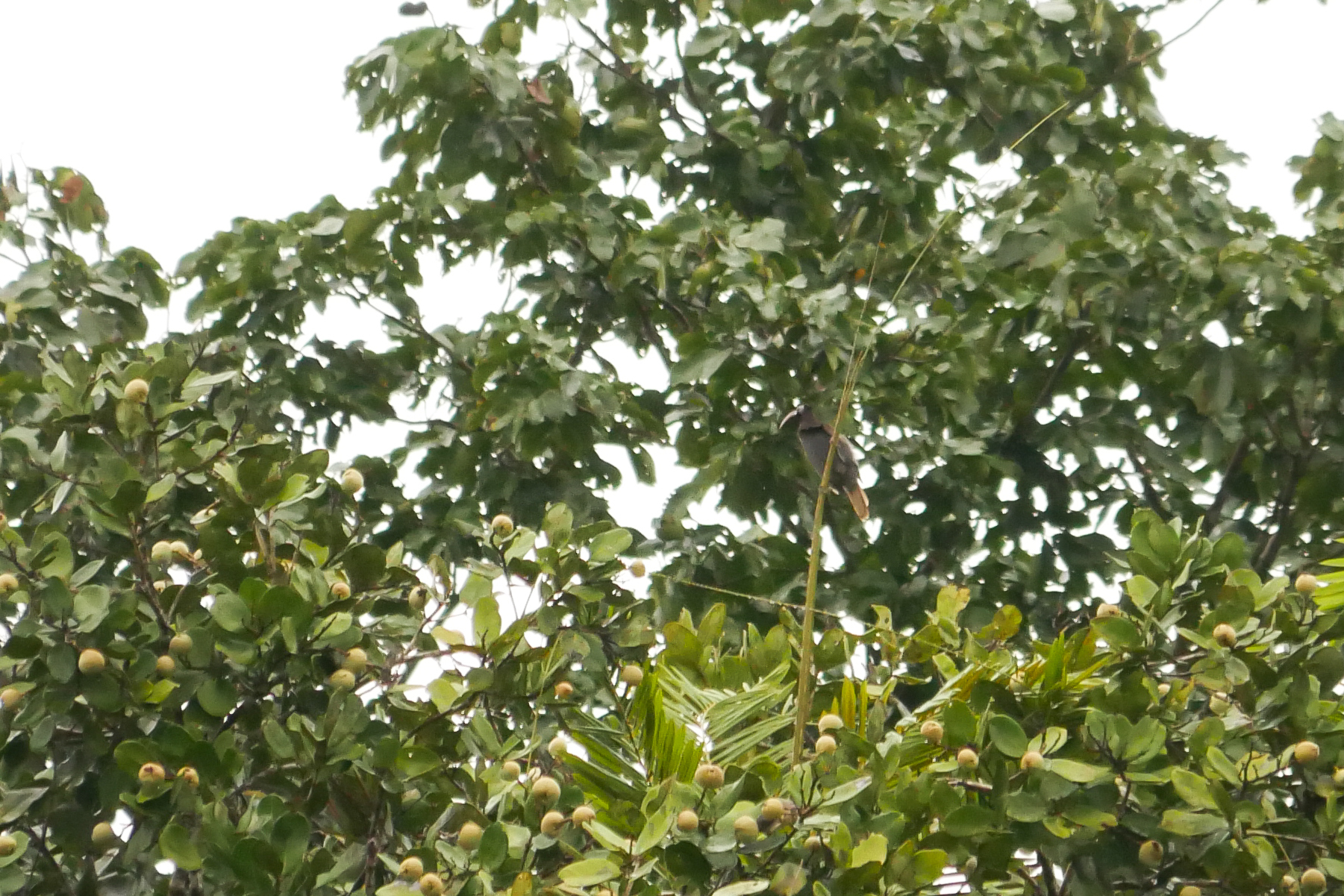
Then in lovely light – though distant – a male Lesser Bird of Paradise flies across our view, a lifer target for Jon. His staggering yellow plumages seem to gather the evening sun as he bounds across the horizon from one fruiting tree to another. The BoP looked nice too. As the afternoon draws on we find another BoP perched up on an exposed stem of a palm: this our first Twelve-wired BoP, probably a young male or female. We hope for better encounters over the next few days.
The birding slows and afternoon turns into evening but we have had a refreshing couple of hours. The morning’s delays and travel cock-up are forgotten and we return to the lodge where a cracking meal and our treat – an esky full of ice and cold beer – are waiting.
Day 7, 18/7/18, “In the court of the Crimson King”
When we planned the trip, originally I was not going to do the Lake Habema leg, instead aiming to join Jon and Steve in Nimbokrang. When the chance opened up to be away for three, instead of two and a bit weeks, I changed my travel and joined them right from the start, so in some respects the previous week has been a bit of a bonus, and in a funny sort of way, it almost feels like the real trip starts now. Certainly in terms of the really iconic species, today has been circled in red on the calendar as a potential block-buster.
We begin in the pre-dawn darkness, down near the tower hide, doing some owling. This has necessitated a 3.40am rise. I am especially keen for Papuan Hawk Owl, but our luck is not in. We hear a vague response to my playback but although the locals claim a young Hawk Owl responding, I am not convinced that the single note hoot is actually a Hawk Owl (whose normal call is a double note). On the other hand, I have no alternative theory for what it might be! Whatever it is, it refuses to come any closer. A few Marbled Frogmouth utter their bizarre bubbling call (followed by a pop that sounds for all the world like a finger plucking a cheek). As we leave, one flies across my torch beam, but disappears into the forest without landing. As good a bird as Marbled Frogmouth is, it’s a non-lifer, non-endemic and we have bigger fish to fry.
We arrive while it’s still dark at another tower hide that Alex has erected looking up to a display post. Worryingly there is a large group of birders gathered at the base. We’ve been assured that as the only group actually staying at Alex’s we have some priority and were promised the top level of the hide. Hoping the assurances hold good, we push past the waiting punters, a group from the Netherlands that it turns out will from now on share a very similar itinerary to us, getting in the way or forcing us to change our plans (for this reason we christen them the Ducking Futch) and – much to their irritation – go straight up the tower. It’s not our fault or our problem that their leader and ground agent have mis-communicated with Alex, so we ignore their heated whispers and ascend to the top level. In the pre-dawn gloom we can make out an obvious straight, dead tree that must be the display post. A few moments later, Alex, trying to keep everyone happy, appears and asks if we mind a couple of them joining us, because there is not room for their unfeasibly large group on the lower deck. We reluctantly agree. But we didn’t arrange a trip with just 3 of us only to end up birding in a group of 13, so we make sure we have the best viewing spots covered and yield only once we are sated with views and images. Fortunately, this pisses them off royally 😉.
As the first rays of light appear, a bird flies in and lands on the top of the post. I whisper excitedly: “It’s there”! But it’s just a Dollarbird. In fact we have to wait for another 30 minutes, tensions rising, Dutch birders trying peer over our shoulders and encroaching on our personal space that we try jealously to protect! Then the moment we have waited for: a Twelve-wired Bird of Paradise — the pole dancer himself — lands on top of the post. The light is still not brilliant but we fill our SD cards as it preens, then does a few moves on the post. Sadly, this bird is partial-moult so lacks the full complement of massive bright yellow breast/belly feathers. He stays for about 20mins, then, with apparently no female appearing, flies off into the forest. We too depart, walking off with our guides deeper into the forest, leaving the Dutch to admire the empty post from their now unobstructed viewpoint.
We have another top target for the morning and our guides take us to a platform that looks up to a tree where, allegedly, King Bird of Paradise displays. There are none here and we walk further into the forest where the locals know of another display tree. We arrive and crane our necks unoptimistically to branches almost directly above us. Benny plays the call and amazingly, almost immediately it is answered – there is a bird here. And then, far above us, there he is, a small jewel of crimson and white. The funny green coins on the end of his two thin tail spines are invisible, hidden behind leaves, but he shimmies up and down his branch and we see them bobble out behind him. He flits away, but is soon back, then is joined by a female, ratcheting up his excitement level noticeably as he repeatedly comes back to the same vertical branch and works his way up it. Then another couple of males arrive and more female and we have a full-on-lek, with birds flying left and right, jostling for position on the prime perch. Though our viewing angle is abominable we lock our necks at 90 deg for the duration and have perhaps our most memorable experience of the trip so far, poor images and even poorer video unable to capture the true feel of the moment. After 30-40 minutes we drag ourselves away, privileged to have spent some time in “the court of the Crimson King” (coined by Steve who makes a smug note of the phrase – and hopefully won’t be too pissed off at my breach of copyright).



As we walk back along the trail we find another goody, Papuan Babbler. A group of 2-3 birds plays hard to get but eventually we all get decent views of at least one of them as they busily move about low down and in the mid-storey of the forest. These “babblers” are from the Australian, not the South-east Asian family of the same name, so they are structurally similar to familiar mallee birds like White-browed and Chestnut-crowned with long tails and long down-curved beaks. I quite like adding these Papuan additions to Australian families. Papuan Treecreeper was another, likewise Australasian and not related to the old world treecreepers, though filling a similar ecological niche. I am also reminded of a glaring miss in ’08 when we came “this close” (imagine my finger and thumb are just a cm apart) to seeing Painted Quail-thrush, the only New Guinean member of this fabulous, desirable family of which I have seen 3 of the available 7 Australian species
When we woke before 4am it was still 30deg plus and near 80% humidity. It’s now 9am and oppressive. We rest at a viewpoint, downing copious amounts of water, but avian activity is minimal.

Once we are somewhat recovered we decide to walk back to the lodge. En route we spend some time with a Black-sided Robin, and then as we approach the lodge a Papuan Dwarf Kingfisher zooms across in a tiny blur of blue and gold.
Back in the open-air dining room Shita is waiting with a superbly refreshing home-made iced drink of cucumber and juice. We have an early lunch (Black Sunbird and Red-capped Flower-pecker pose nicely in the trees next to our table), then rest. Bird activity is minimal at this time of day so there is little point in flogging ourselves around the jungle again.
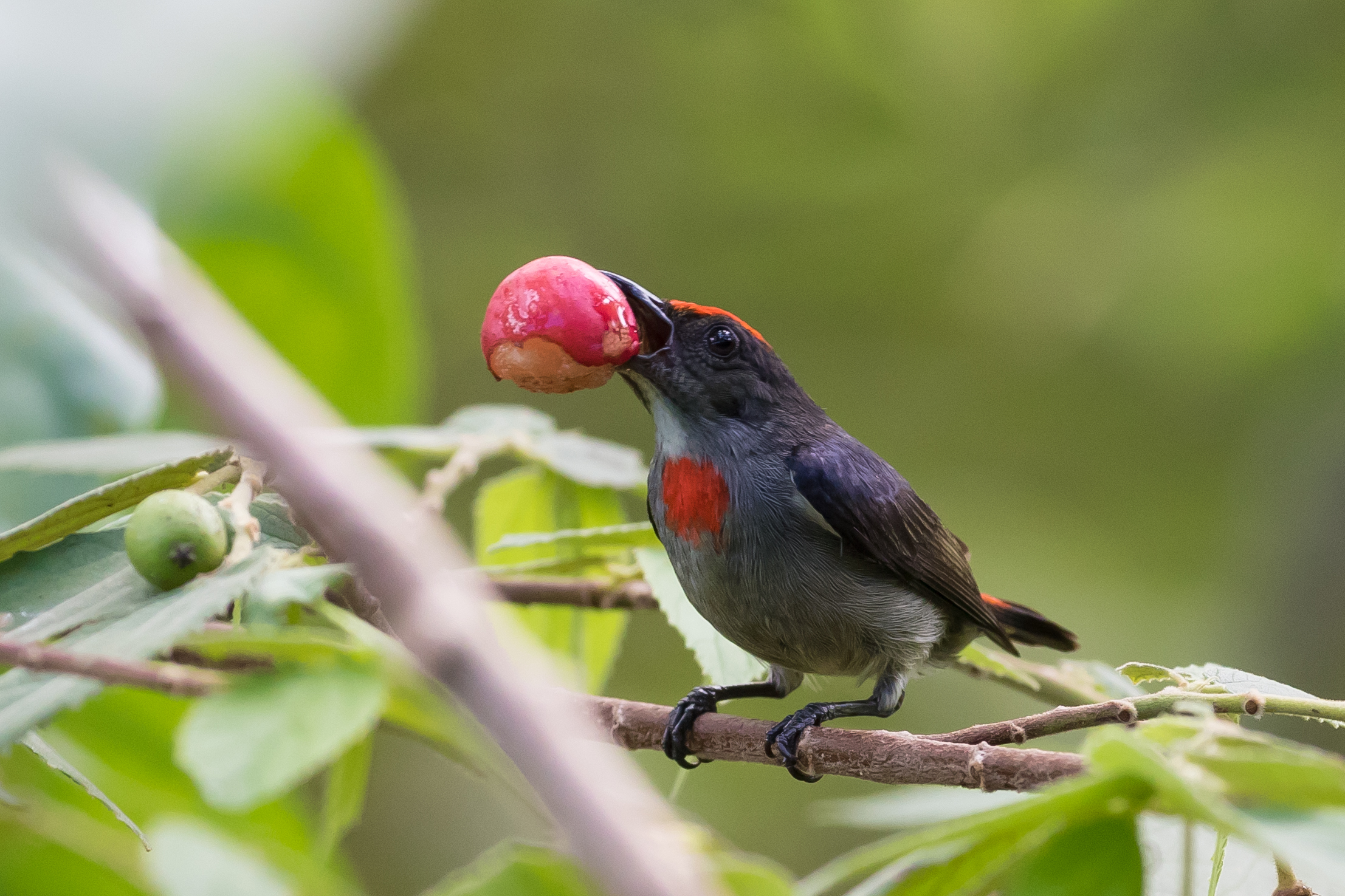
At 3pm we are back on the road, this time heading to an area of gardens looking for birds of the open grasslands. The area has a distinctly Australian feel to the avifauna with Willie Wagtails, Rainbow Bee-eaters and Sacred Kingfishers all prominent. We find a good sized flock of Grand Mannikin here, and add a few Crimson Finch (though also found in Australia, this is a lifer for me). We are hoping for Hooded Mannikin but despite searching through all the Grands we find none.


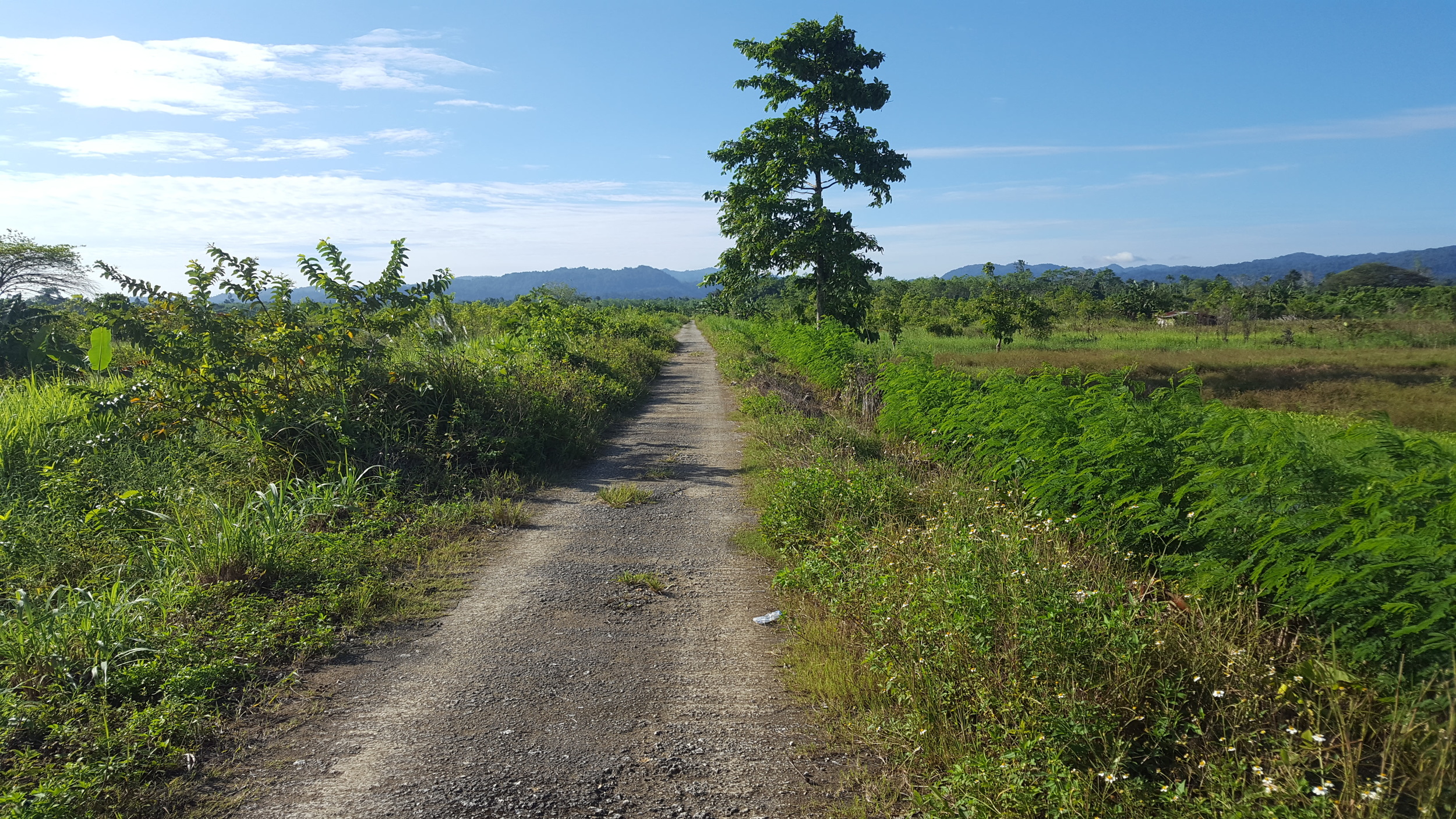
Our plan is to spend the last 2 hours of daylight at km9 on the road beyond our village where we are told there is a nice lookout with a few species we’ve not yet found. It takes 20min to get here and we are dismayed to see the Dutch minibus parked up on the roadside. We are pissed off, but unlike this morning we can claim no priority. Benny is especially put out – he chatted with their ground agent over lunch and told them this is where we planned to come. Their guy said nothing. The least he could have done is tell us their plan so we could have chosen to do something different – we have a gnawing suspicion it’s deliberate. But deliberate or not, we have no desire to bird in a big group. Instead we turn around, wasting good birding time to drive back to Alex’s and bird once again from the tower. We observe similar species to yesterday, finding nothing new.
Once it’s dark we head to a new location, led by local land-owner Danche, who says he has a good spot for Papuan Hawk-Owl. We pull up in the vehicles and he indicates a set of trees across a small bridge. There is nothing here but we follow on foot along a trail through fields and gardens en route to another spot he knows. “Not far”, he says. Yeah right — We have heard that before in New Guinea! Having walked nearly 2 km through these fields and still with little sign of the woodland we imagine is needed by the Hawk Owl, we come to a stream. Inspection in our torchlight reveals near-vertical muddy banks and a thin, precarious log acting as a bridge. Danche crosses, but Benny gets half-way down the bank and his wellies sink a foot into the soft mud and stick fast. Personally my confidence that Danche will actually deliver is pretty low, and I really don’t fancy risking falling and getting hurt (an injury could jeopardise the next two weeks birding) or damaging expensive optics trying to cross by torchlight for the small chance of Hawk Owl. Jon and Steve clearly feel the same way so we indicate to our team that we are going to turn back. The trip is not a total waste, though, because as we retrace our steps we get awesome views of a Papuan Nightjar that poses wonderfully (“if I keep completely still you can’t see me”) on a fence-post.
Day 8, 19/8/17, “In which we spend hours thrashing through dense jungle and see almost nothing.”
Over dinner last night we have discussed our options. We have one more full day in Nimbokrang followed by a final morning. A place called Jalan Korea, about 30min drive away, seems to hold a few species we still need, including two megas: Victoria’s Crowned Pigeon and Shovel-billed Kingfisher (Kookaburra).
We decide that our remaining priority is to find Victoria Crowned Pigeon. This is one of two possible Crowned Pigeons on our trip, the other being Western, which we hope for at the end of the trip on Waigeo. The Crowned Pigeons are huge, chicken-sized pigeons with an elaborate fan of feathers on their crowns, and a massively desirable family because of their amazing looks and rarity. They are also, according to Benny, the converted hunter, delicious (which perhaps explains why they are rare). We also know now that the BTA crew missed it, and in a childish competitive sort-of way, it has consequently become even more important. Our other topic of conversation over dinner is Benny’s hunting past, and his very poor upbringing. Mambruk (as the Crowned Pigeons are known) for dinner would have been a real treat. This line of conversation coalesces into a plan: we will starve Benny, and then when he is *really* hungry, head out to VCP territory. He will be sure to track one down for us :-).
Jalan Korea is owned by Danche, so, like last night, he will be leading. Hmmm. A 3.30am rise is required to get there in time to do some owling and look for Shovel-billed Kookaburra, though we know that most people miss this elusive crepuscular skulker. Ominously, even before we have arrived we stop to see a car ahead of us bogged. Oh no, it’s the Ducking Futch! Fortunately they are not too badly stuck and with a bit of help from our guys they are on their way again. We follow hoping they will not be in the same spot as us.
We arrive in the dark and from 5am-7am follow Danche down various trails trying for the owls and other crepuscular species. After a trudge for several hundred metres we barely wait for any kind of response before we retracing our steps back to the vehicle then trying a trail on the other side of the road that is apparently better. Why didn’t we go there first? Why have we not tried much at the first spot? Danche, we are rapidly forming the view, is a textbook exhibition of Dunning-Kruger effect, totally misplaced confidence in his own abilities.
In the darkness we hear Hook-billed Kingfisher but fail to see one. I hear a Papuan Frogmouth, and Greater Black Coucal (now Ivory-billed Coucal) are singing all around but we dip again on Papuan Hawk Owl. We do have a Shovel-billed Kookaburra respond to our playback but it is not interested in coming closer and showing itself. By 6.30 it’s getting light and we leave the trail to go back the car for breakfast. The Dutch are doing the same and perhaps they are just as pissed off to see us as we are them. Fortunately we will be heading off into the forest again while they bird the road.
We may not agree with Danche’s strategy, but we have no other plan and have to trust him and our guides. He certainly knows his way around the jungle, which is just as well because within minutes I realise I have no idea where we are or what I would do if I lost the group. We all fall into line again to follow Danche, and walk on hopeful that we will see movement on the forest floor or on the trail ahead. White-eared Catbird calls and is very responsive to our playback but all we see is a dark streak bombing across the trail a couple of times and cannot pin it down for decent views. Later we pause at a clearing where Benny indicates that a chattering call we can hear is Common Paradise Kingfisher. He plays the call and immediately at least 3 birds are interested and we can hear them calling around us. We are aware they are moving about but they are very tough to get onto. Eventually I get views I am happy with, though there is no chance of a photo, which is a shame for such as cracking bird.
We carry on deeper into the jungle, though worryingly the trail becomes less and less obvious, heavily overgrown and we stomp our way through dense palms and vines and other undergrowth affording no visibility. Even if Danche comes across a Mambruk, surely it will flush before anyone can get on it, and the forest is so dense we’d have no chance of relocating it. Indeed this is exactly what happens when he comes across a White-bibbed Ground-dove. For five hours we traipse around the jungle, seeing almost nothing (though we do find some Cassowary footprints, which is exciting). We add only two new birds: Ochre-collared Monarch (a cracking looking split from Frilled Monarch) and Emperor Fairywren. Steve manages some decent photos of the former.
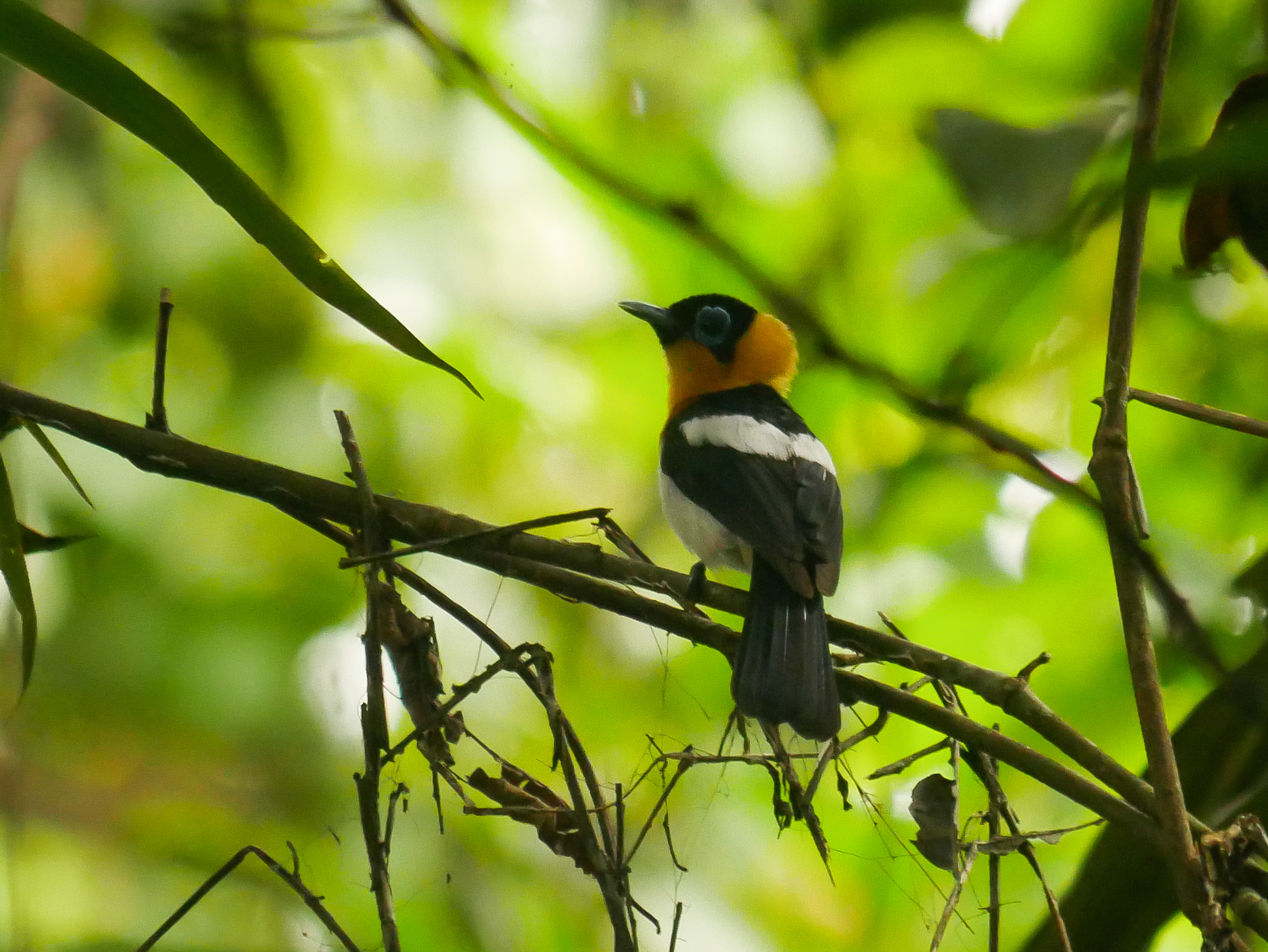
We are about to emerge to the vehicles when one of the locals excitedly comes to get us. While we have been bombing about apparently aimlessly following Danche, another of the guides, Martin, has been pursuing a different strategy. Moving quietly and alone in a different area he has been looking for fruiting trees — he has hit the jackpot with a Crowned Pigeon feeding quietly on fallen fruits on the ground. It has flushed up to a branch in the tree and he is confident it will still be there. We hurry after him to the spot, a few hundred metres along the road then down a short trail into the forest, barely able to believe our luck. Martin moves cautiously and peers up into the tree, moving his head back and forth to change the angle. Arrgghhh! It’s gone! 😞
We spend the next hour searching the vicinity, hoping it will not have gone far, but we draw a blank. So close, yet so far. Eventually heat, hunger and a significant drop in the enthusiasm levels mean we knock it on the head and travel back to Alex’s. Once again Shita has prepared a superbly refreshing iced drink that helps us recover and regroup. We reflect that it was always a long shot, though in all honesty we had not expected it to be quite so birdless, and the tactics to find the pigeon so blunt!
After lunch we spend an hour back at the Mannikin site, but we are too early and find only a single Grand Mannikin. We do grab a lifer for all of us when Jon picks up a distant large bird which we identify as Great-billed Heron through the scopes. Then we drive back to km9 and spend 3.30 until sunset looking out from our elevated viewpoint. As from the tower over the previous couple of evenings, most of the birds we see are ones in flight, shuttling from fruiting or flowering trees to their roosts. We note Western Black-capped Lory, Sulphur-crested Cockatoo, Coconut (Rainbow) Lorikeet, Brown Lory, and Blyth’s Hornbill. Jon finds a Lowland Peltops. I observe this casually, thinking it’s a non-lifer but reference to my trip list later on reveals that it was one I needed. Indeed Steve was even more casual and failed to get on it. He does, however pick out some distant Vulturine Parrots in flight but neither Jon nor I can get on them before they disappear behind a distant ridge. No matter, I saw lots of them 10 years ago in PNG (though they were one of my birds of the trip back then). Best bird here is Papuan Spinetail, wheeling about with Uniform Swiftlets above our heads.
Back at Alex’s we reflect on a dispiriting day. As we enjoy cold beers and another fantastic meal prepared by our hosts, we consider our options for tomorrow. We have another morning, and even all afternoon if needed, for our remaining targets. We devise a new, cunning plan and get our local guides to buy into it. They think it might just work!
20/7/18, Episode IX, “A new hope”
We have finished the previous day’s slog by forming a new plan for today, our last day in the lowlands of Nimbokrang. Benny and the local guides believe we still have a chance of Victoria’s Crowned Pigeon in a spot where they are not usually seen, but where Martin – yesterday’s finder – thinks they might be. Our experience over the last two days has led us to realise that Martin is the key guy. Though Danche might bluster his over-confident way around, Martin is the real brains of the operation. His understated, quiet modus operandi disguises the fact that he is the one with the knowledge and genuine field-craft that has at least an outside chance of delivering for us.
VCP is low chance, so our new strategy, rather than putting all our eggs in that basket again, will be to bird as if it’s not on our target list. But when we are close to where Martin’s instincts tell him we could score, we will send the “Mambruk whisperer” off to try and locate one. His chances are greatly increased if he goes alone, and if he does find one, we will just have to cross all spare fingers and toes and hope it stays put long enough for us — unlike yesterday. In the meantime we will go to a different Twelve-wired stake-out, walk briskly through the forest to try and connect with a Lesser BoP lek, then bird Alex’s forest while Martin tries to weave his magic.
Up at 4am (a veritable lie-in compared with the last two days) we drive a short distance beyond the village then walk for 20min in the dark along another dense forest trail. A Papuan Frogmouth hoots its repetitive call, and Hook-billed Kingfishers call all around us but we cannot stop because we need to be at the tower hide before first light. From 5.30 til 6am we are in a more private tower hide, no other birders pressuring us from behind and we have a much more relaxed, intimate and just better birding experience.



At 5.40, much earlier than Wednesday, a male Twelve-wired Bird of Paradise appears on the display post in front of the hide. This bird sports the full set of yellow breast/belly feathers that Wednesday’s bird lacked, but curiously seem to be moulting its twelve wires – at least we cannot see the weird curly tentacles that give the bird its name. This does not, however, deter the females! Soon after he arrives, a female also stops in, and then another. The male is sent into his full display, shimmying up and down his pole. The chosen female joins him on the post and they go through a courtship ritual ending with mating! What a cracking start to the day (for us as well as them, though in the jungle a long way from loved-ones, we can only dream of morning sex [*]). We are glad we have made the decision to revisit a Twelve-wired display.
As soon as they have mated, they fly off into the forest for a post-coital cigarette, and we hasten down from the tower and follow Martin along a narrow, little-used trail as quickly as we dare, hoping to connect with a Lesser BoP lek.
We arrive at 6.20 and there are indeed still a couple of Lesser BoPs high up in their display tree. We are accustomed, from our experience in the Adelbert Mtns a decade ago, to witnessing display high up in the canopy, semi-obscured by various leaves and boughs – not for us the eye-level views that Sir David enjoys because the BBC team arrives replete with experts who can make rope and pulley systems and fashion a hide in the canopy. Never mind, we have some nice encounters with 2-3 male Lesser Bird of Paradise in their display tree and nearby.
We then find another BoP perched up on a tall palm behind the Lesser BoP tree – female Twelve-wired. Another bird joins it lower down: Glossy-mantled Manucode. Then the Manucode flies, only to be replaced by a male Pale-billed Sicklebill. Minutes later we find another (or the same bird) even closer and grab our first decent images of Pale-billed Sicklebill.
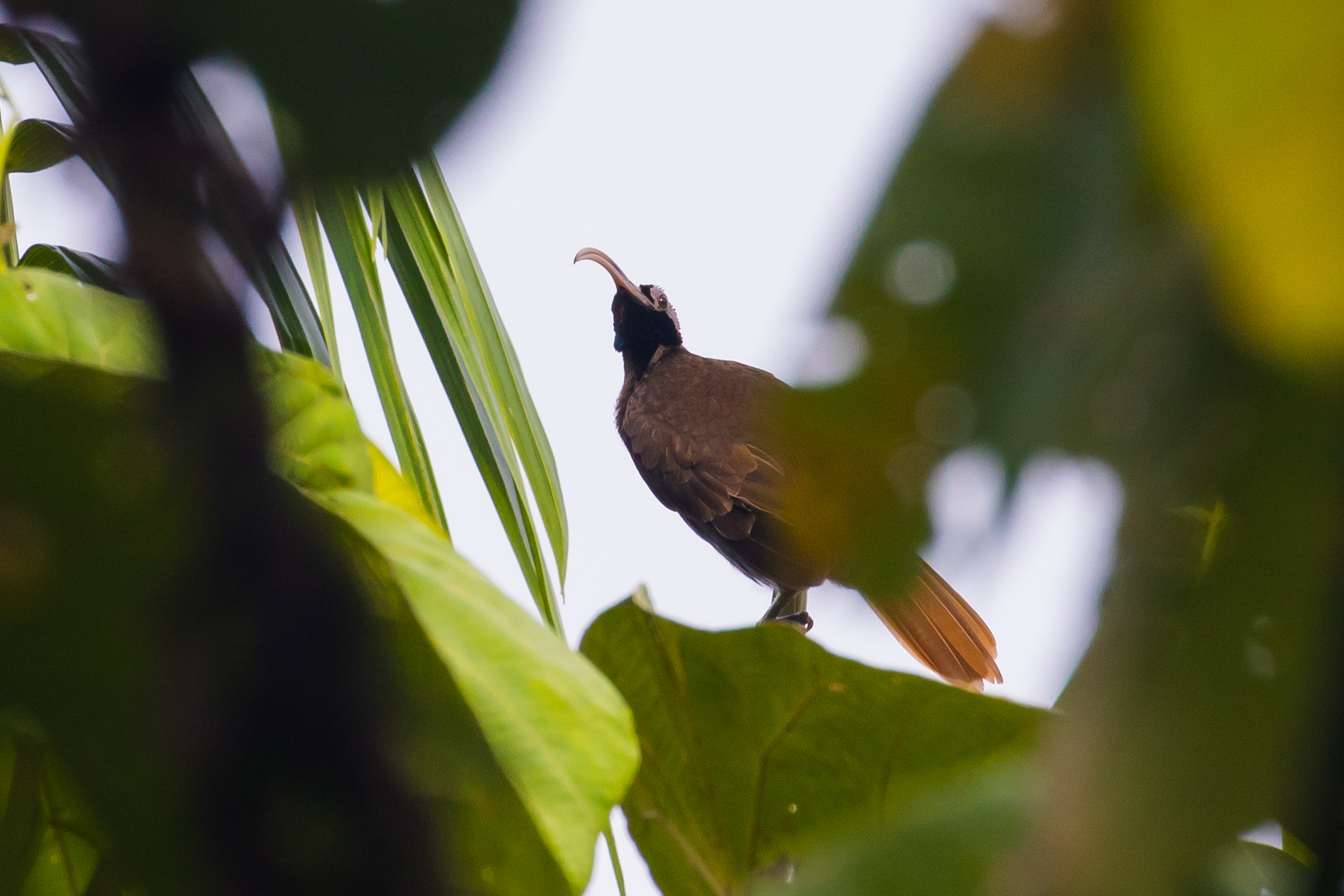
Benny then finds another elusive goody, Golden Myna.
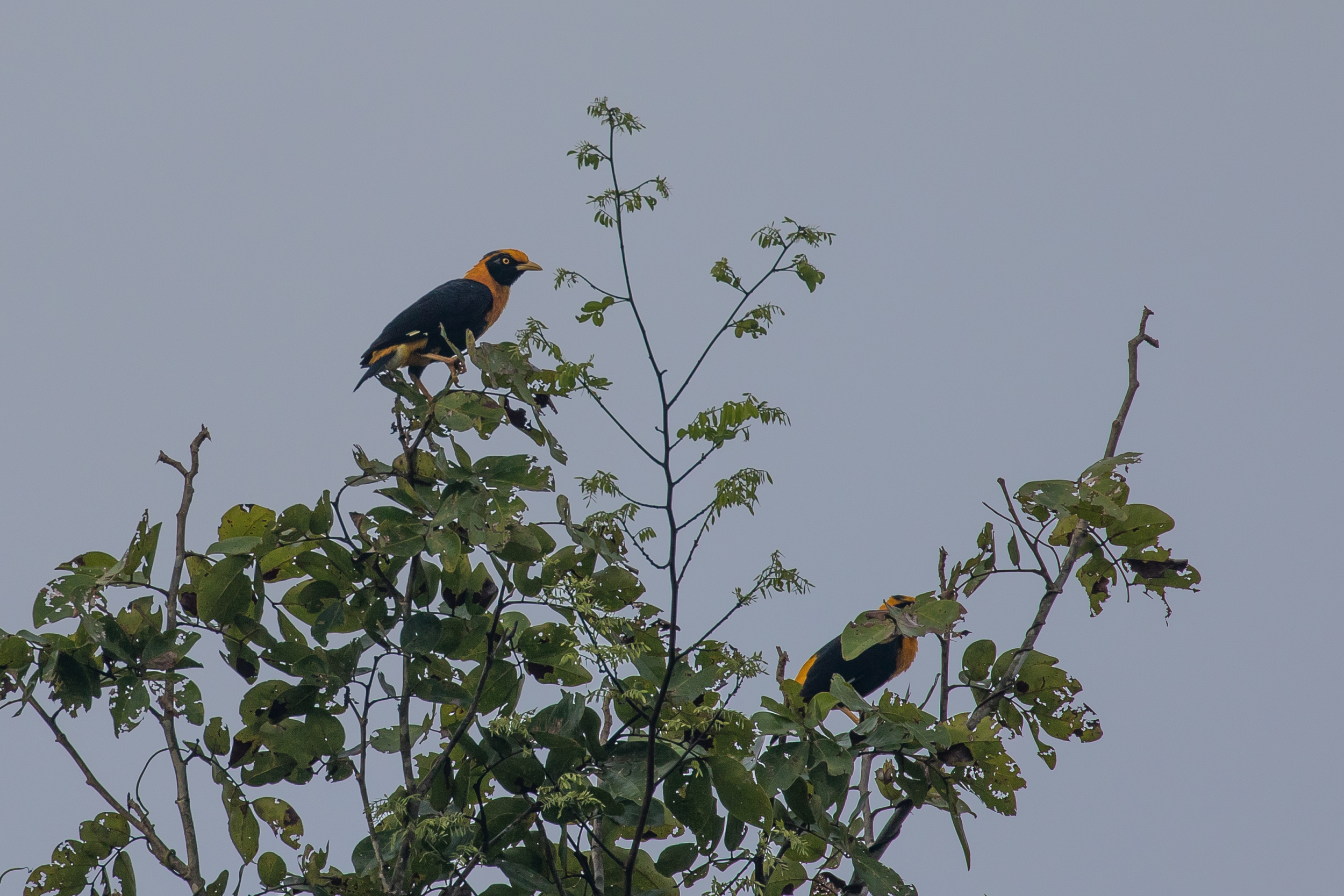
Before at 7.45 we descend into the forest again. Martin makes a short foray and returns to point us to a nesting pigeon. It is a Beautiful Fruit-dove, a lifer and our only one of the trip.
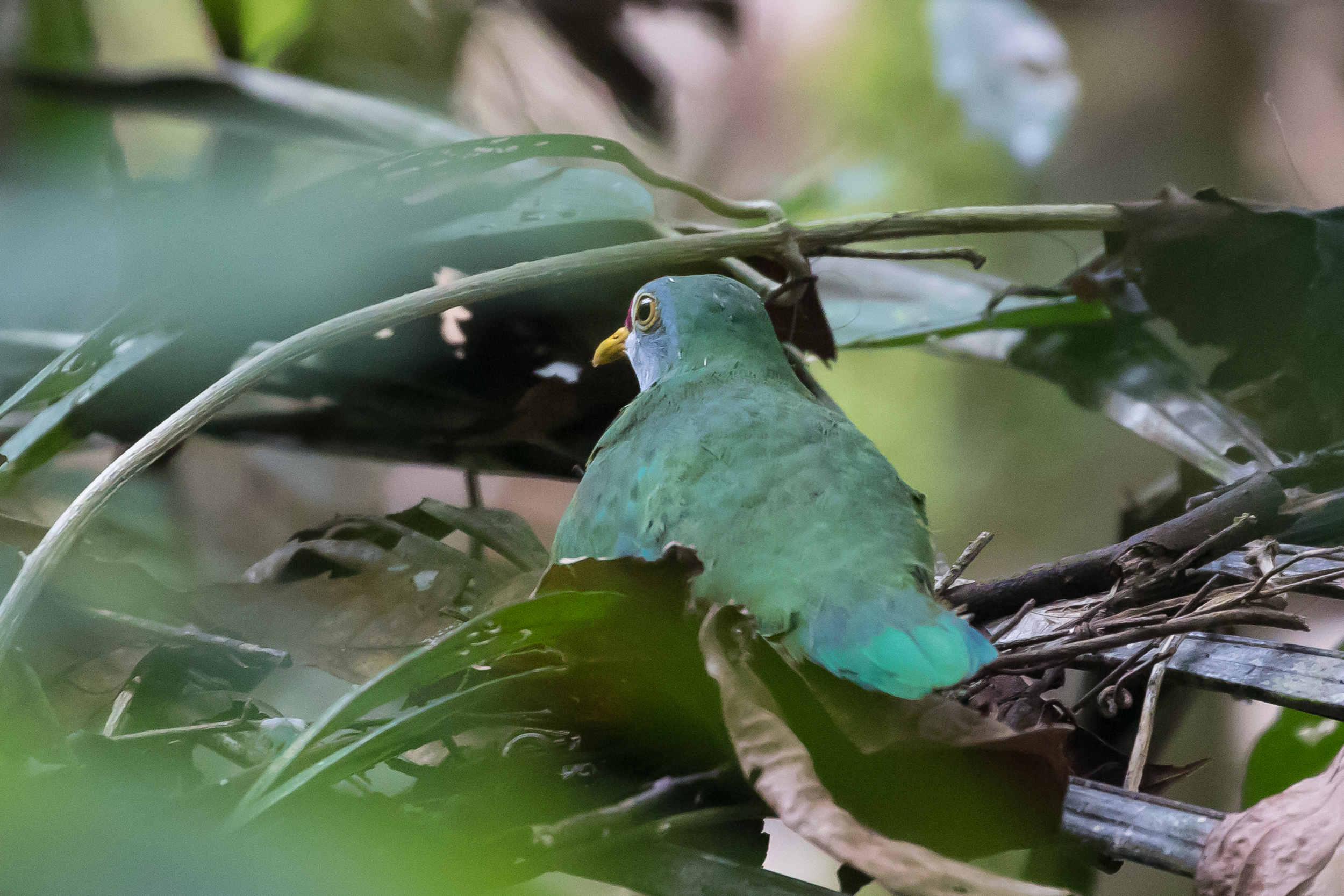
We enjoy lovely views of this female bird then wait around in a clearing while Martin wanders off to where he has a hunch there might be Mambruk. We are not hopeful, but it’s worth a shot, surely? We hear King Bird of Paradise, then find a Rufous-bellied Kookaburra.
At 8.15, one of the local guides appears, somewhat out of breath but grinning from ear to ear. Surely not? But yes, the news is Martin has got one! The tension rises immediately and we brace for action. It’s easy enough following the guide at some pace along the narrow jungle trail, but then we have to go off piste. Lithe Papuan bodies are designed for and accustomed to slipping through the dense vegetation, but these lumbering westerners catch feet on vines, tangle clothes in wait-a-while vines and finding the right balance between haste and stealth is impossible to judge. I am hot on Jon’s heels, Steve just behind me I hear Steve muttering under his breath behind me: “Come on, come on!!!”. Or maybe that’s the clean version. I can’t recall.
We see Martin crouched about 1m below us and Jon scrambles down. I have realised over the last week that Jon is not only quick on the draw and very sharp in his skills, but he also has a knack of being right place right time, whether that’s first on the trail, last in line, or even peering at a different bit of forest. He crouches, lifts his bins and exclaims quietly, “Oh yes, I’ve got it”. I take the three more steps forward, plant my feet behind Jon and start to crouch to get a view when suddenly he announces, “Flying!”. I lift my gaze and see a vague shape zoom off to the right. Steve, a metre behind me has seen nothing, and in an instant we have gone from the tensest, joyful anticipation to the deepest misery. Steve, never one for hiding his emotions, and also the most creative swearer I have ever known, is off on an expletive laden outburst of despair and disappointment. With the bird gone, our chatter rises and Steve continues to curse. Suddenly the cry goes up – “There’s another one”. “And another”. Two more VCP have just flown, following the first. Unbeknown to us there were in fact three Victoria’s Crowned Pigeons in the same tree and we have just missed all of them.
As Steve continues to f and blind, I am quiet, but I am feeling exactly the same. After a minute or two’s wondering WTF we are going to do, Steve follows one of the guides in the general direction the birds have flown. I hang about waiting to see what Martin’s move will be, and fearful that bombing through the jungle will have virtually zero chance of relocating these shy birds.
Five minutes later, Julius appears and beckons me. Again? Surely not? Can I bear to have my hopes raised one more time only to be dashed even harder? I follow him in the direction Steve took, Martin and Jon hot on my heels. Two minutes later I see Steve crouching and grilling something much higher up. “Get in here Ian!” he hisses urgently. I slide down, still worried about that delicate compromise between speed and stealth. I peer through the low vegetation, where, partially obscured I can make out *two* Victoria’s Crowned Pigeons. The view initially is shite, but in the knowledge that we are somewhat hidden by the lower vegetation I am able to adjust my position gradually to get a full on view of one of them. To my left, Steve’s view affords both birds next to each other and he bags some amazing pics before one of the birds moves slowly up the branch, pumping its tail as it does so. Is this a sign it’s about to fly again? No; they both stay.
Jon slides in behind and now we all enjoy moments of pure joy. For best viewing and photos I end up lying on my back in the mud, but I don’t care. This is one of my favourite ever birding moments. When we eventually walk back to the clearing where we’d started this episode I rummage deep in my rucksack and pull out my hip flask of single-malt whisky, carried around for just such an occasion. Shots all round!

It is only 9am, but, we head back gradually towards the lodge. Grey Crows fly over a clearing and we hear the Black-sided Robin again, but it’s hot and avian activity minimal. We’ve seen enough megas to be ready for an early lunch. We wash in our basic trough-and-bucket bathroom, pack our bags and rest for a bit before one last bit of birding.
Mid-afternoon we head one final time to the gardens and grassland area but once again can’t find Hooded Mannikin. We add Chestnut-breasted Mannikin to the trip list and find White-winged and Emperor Fairywren, as well as a stunning white-morph Variable Goshawk.

We leave Nimobkrang with a backdrop of yet another stunning Papuan sunset and settle in to the humorously named Hor-Ex hotel. Tomorrow we will fly early to Manokwari, Shita’s home town.
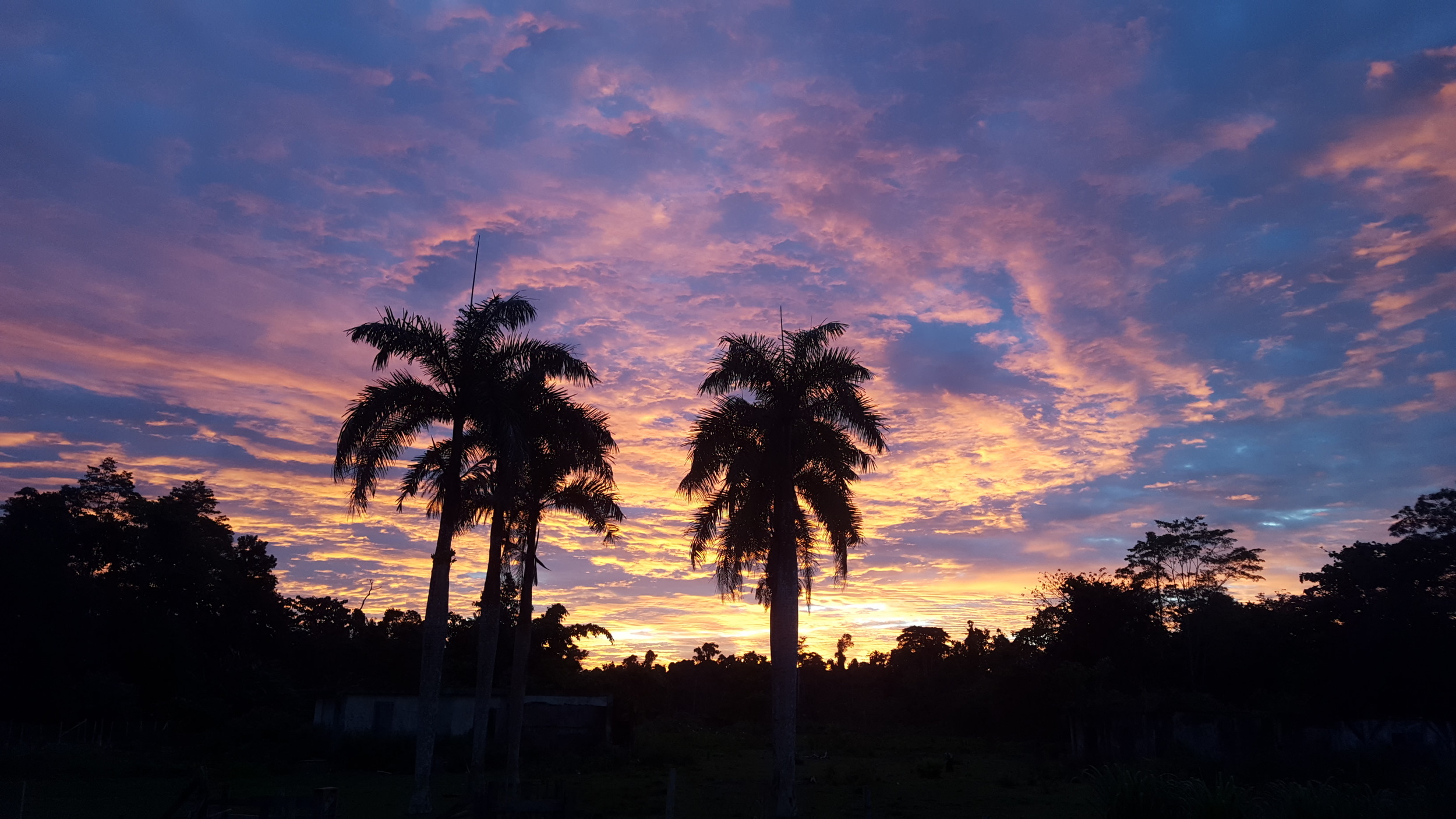
[*] I am reminded of a sign from a hotel room on Manus Island whose poetic motif is almost an order: “You are a long way from home. You have money in your purse or wallet. You are tempted by alcohol and casual sex”.


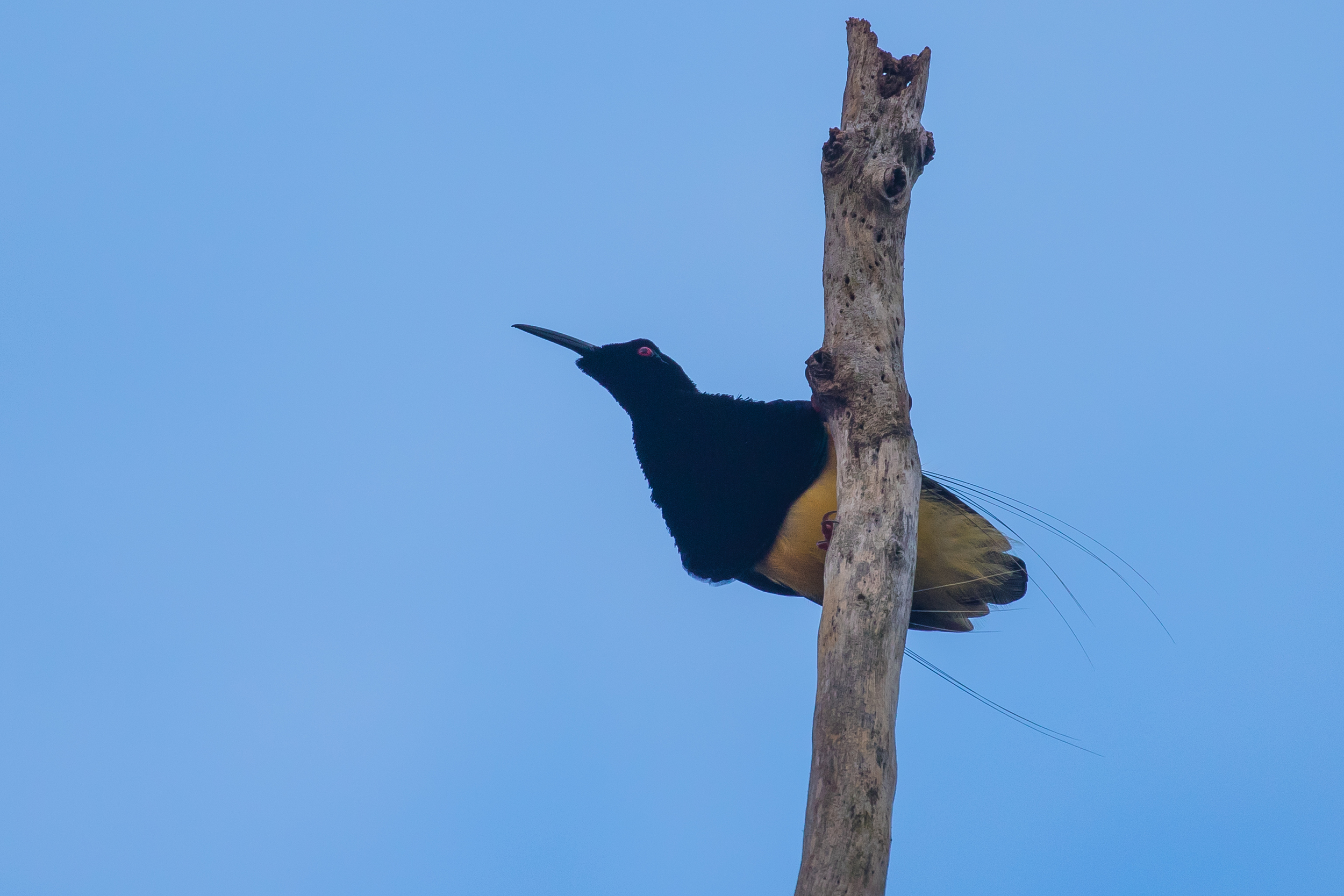
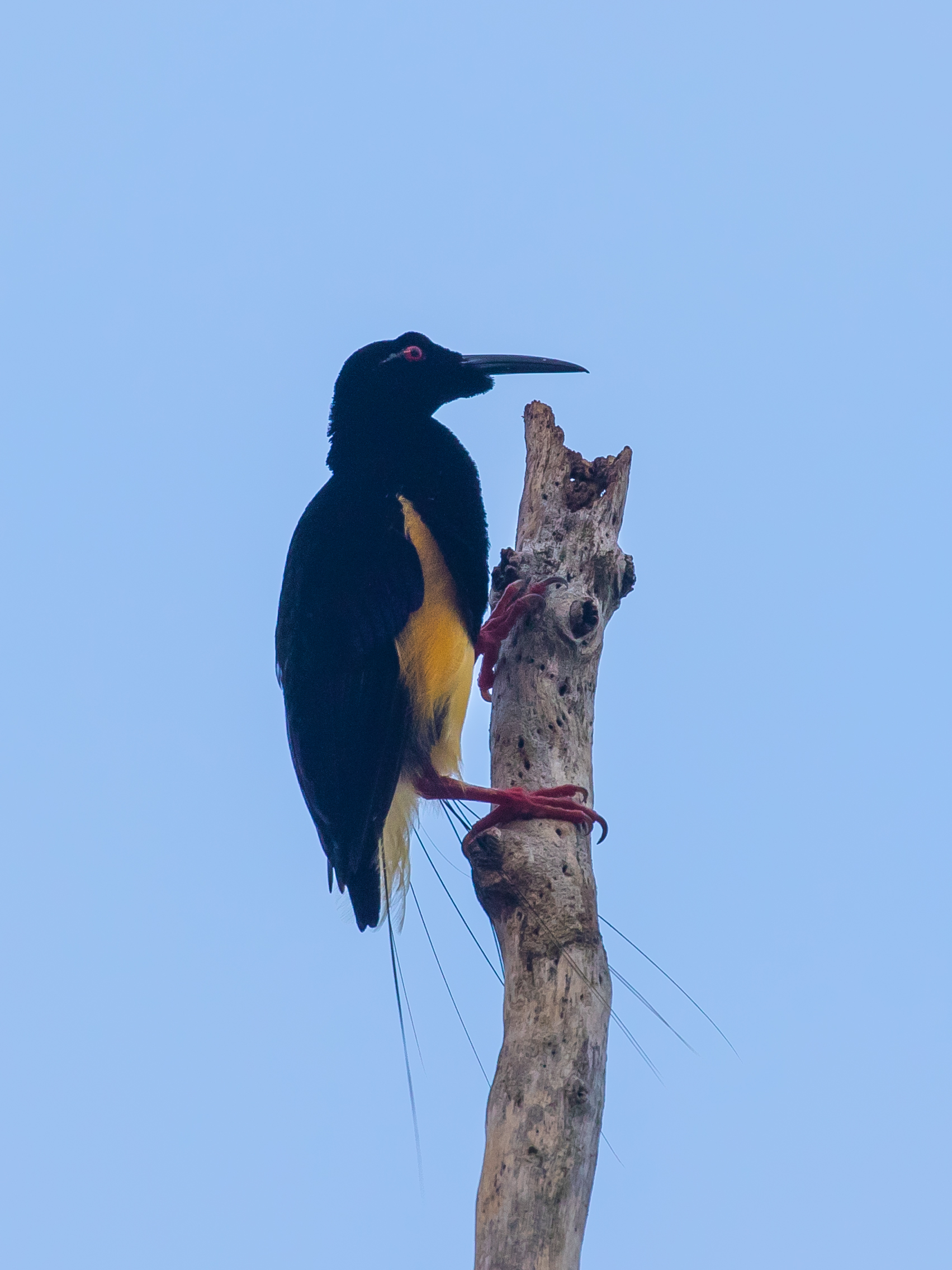
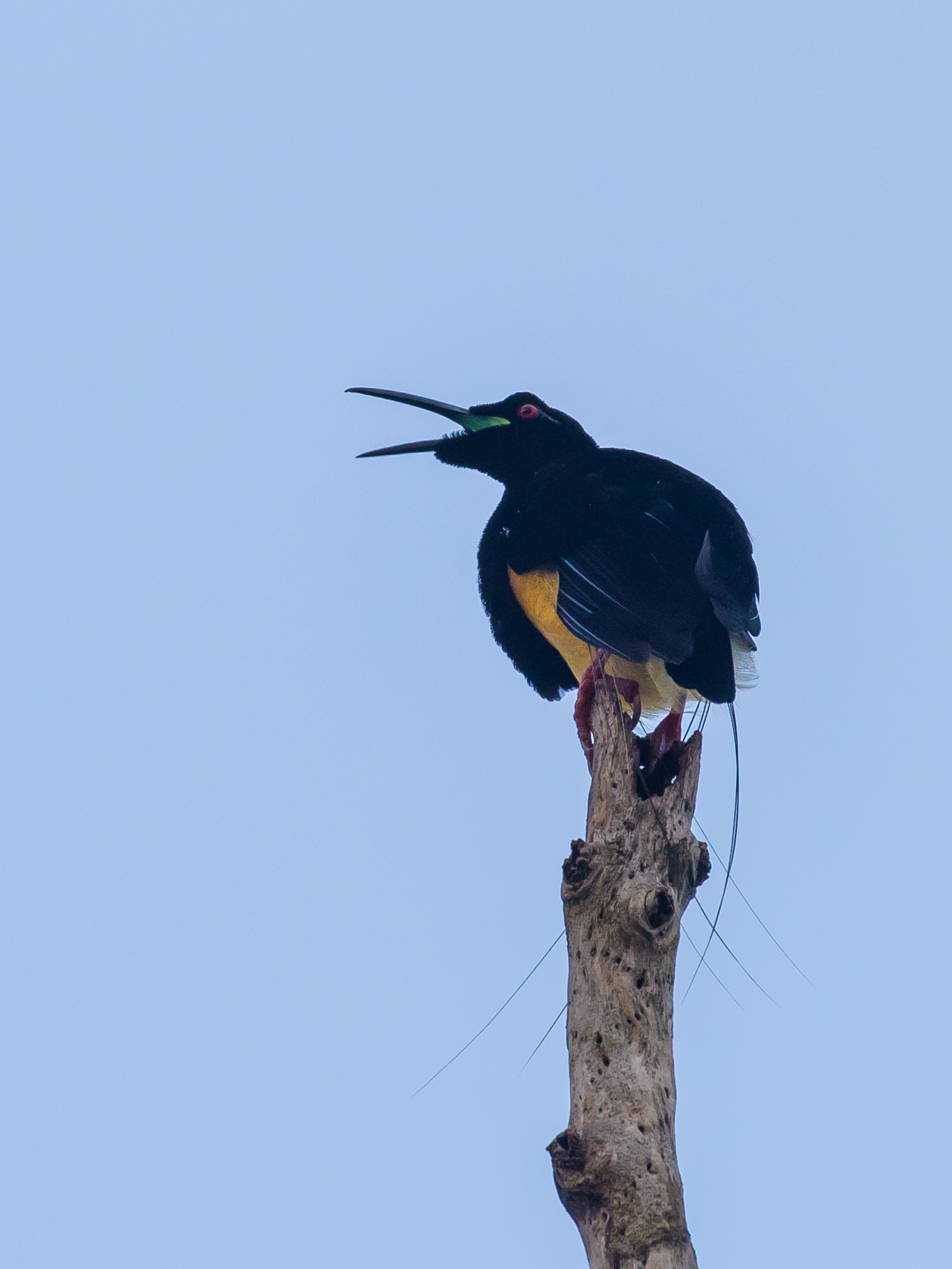
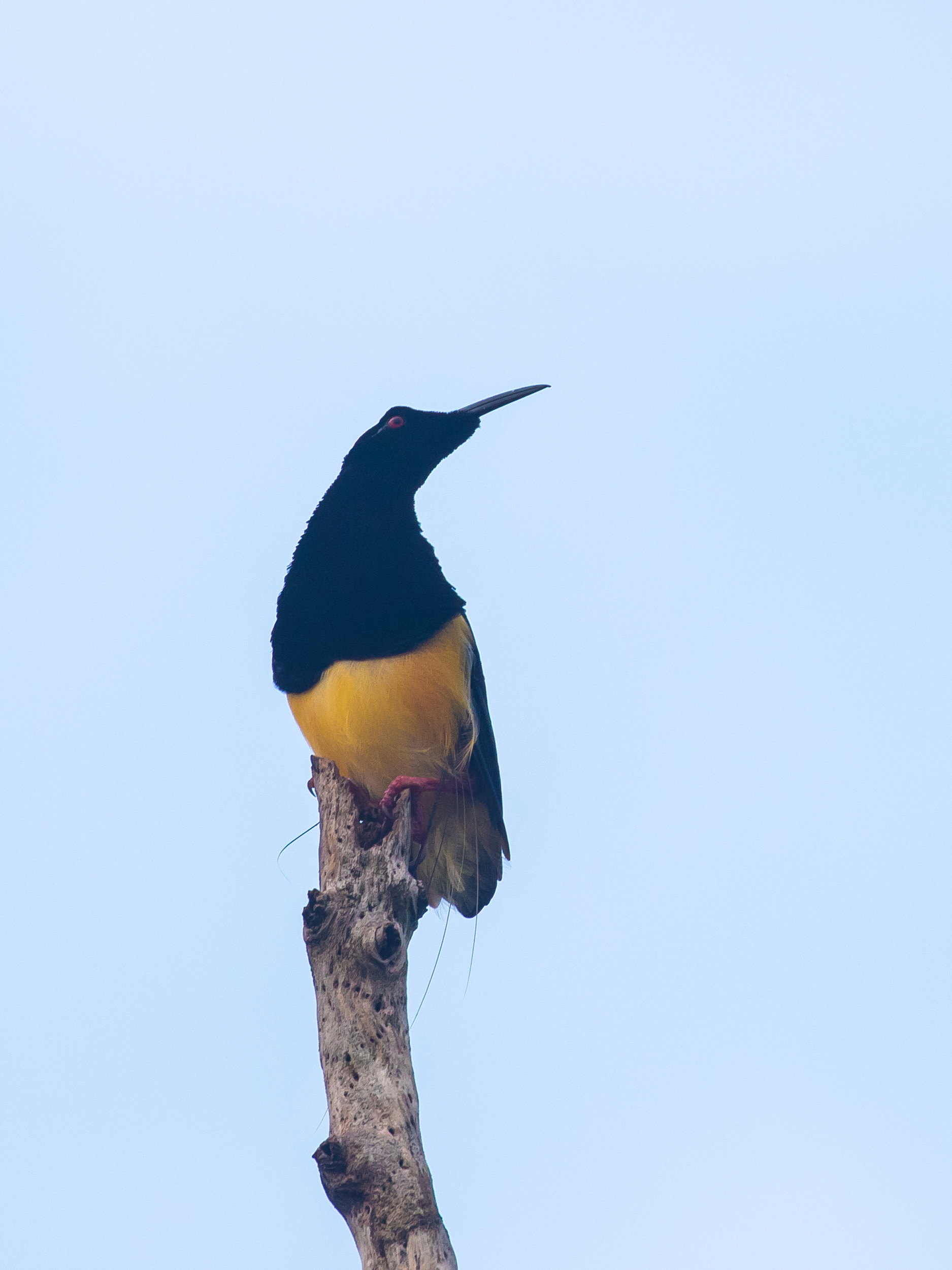
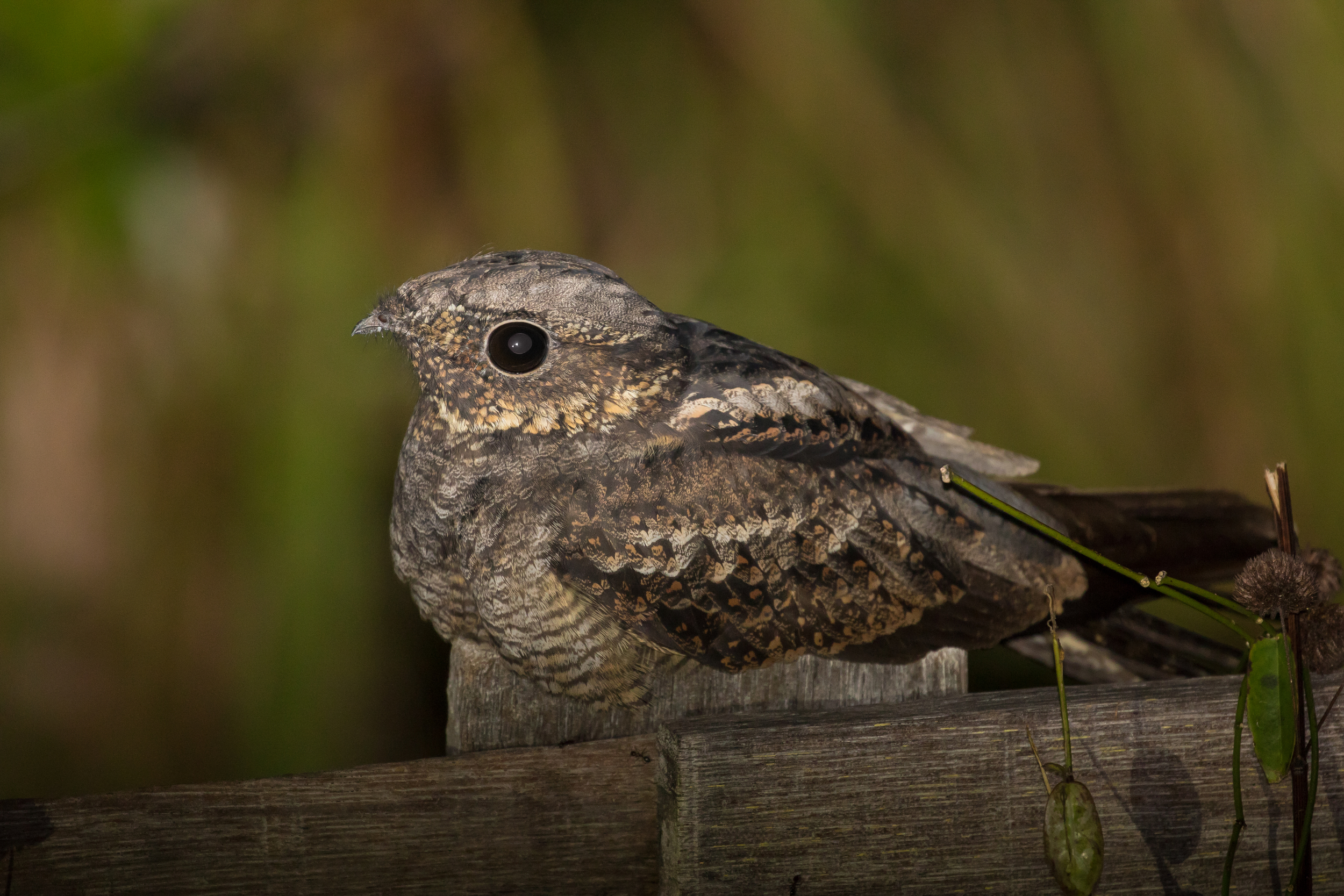
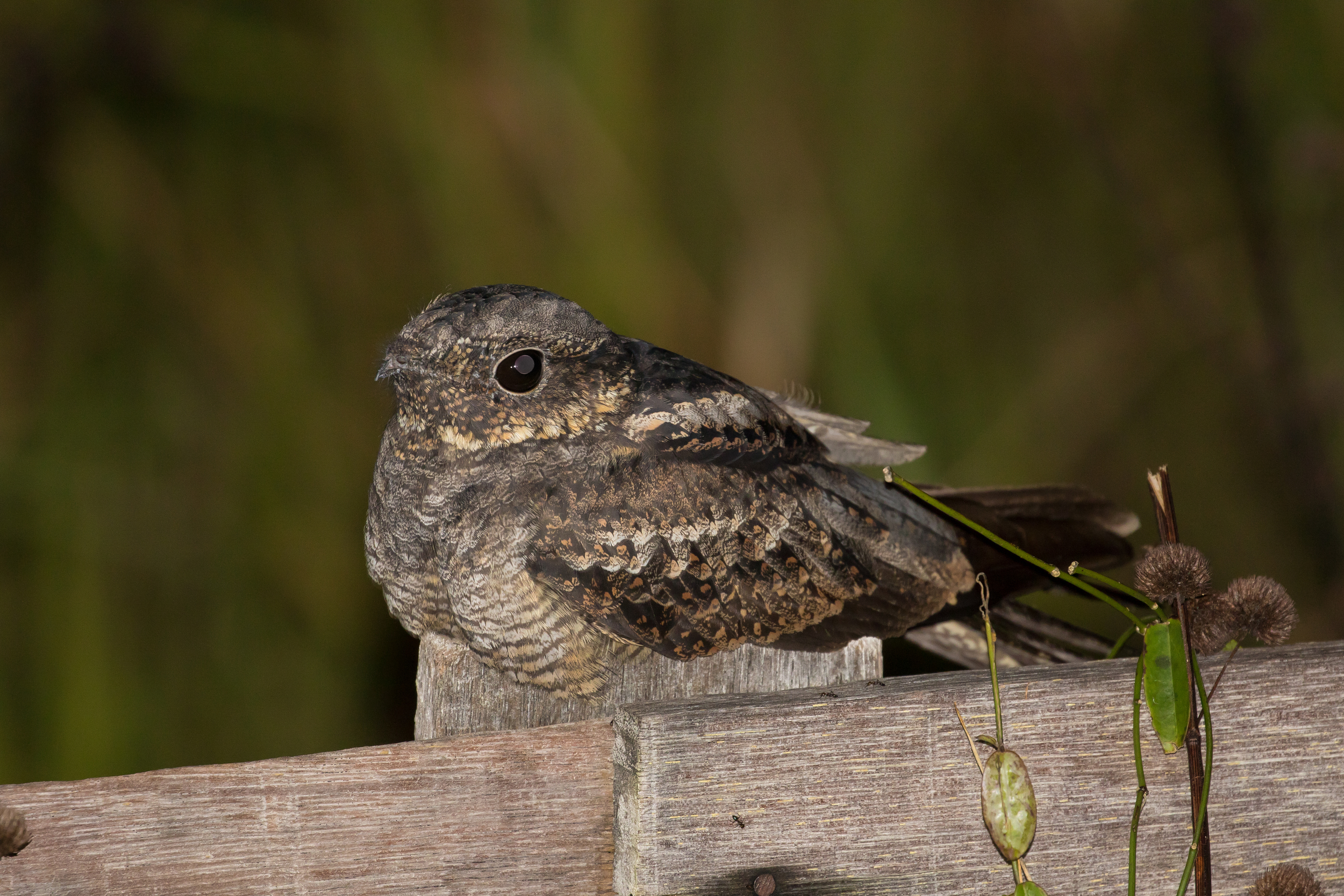
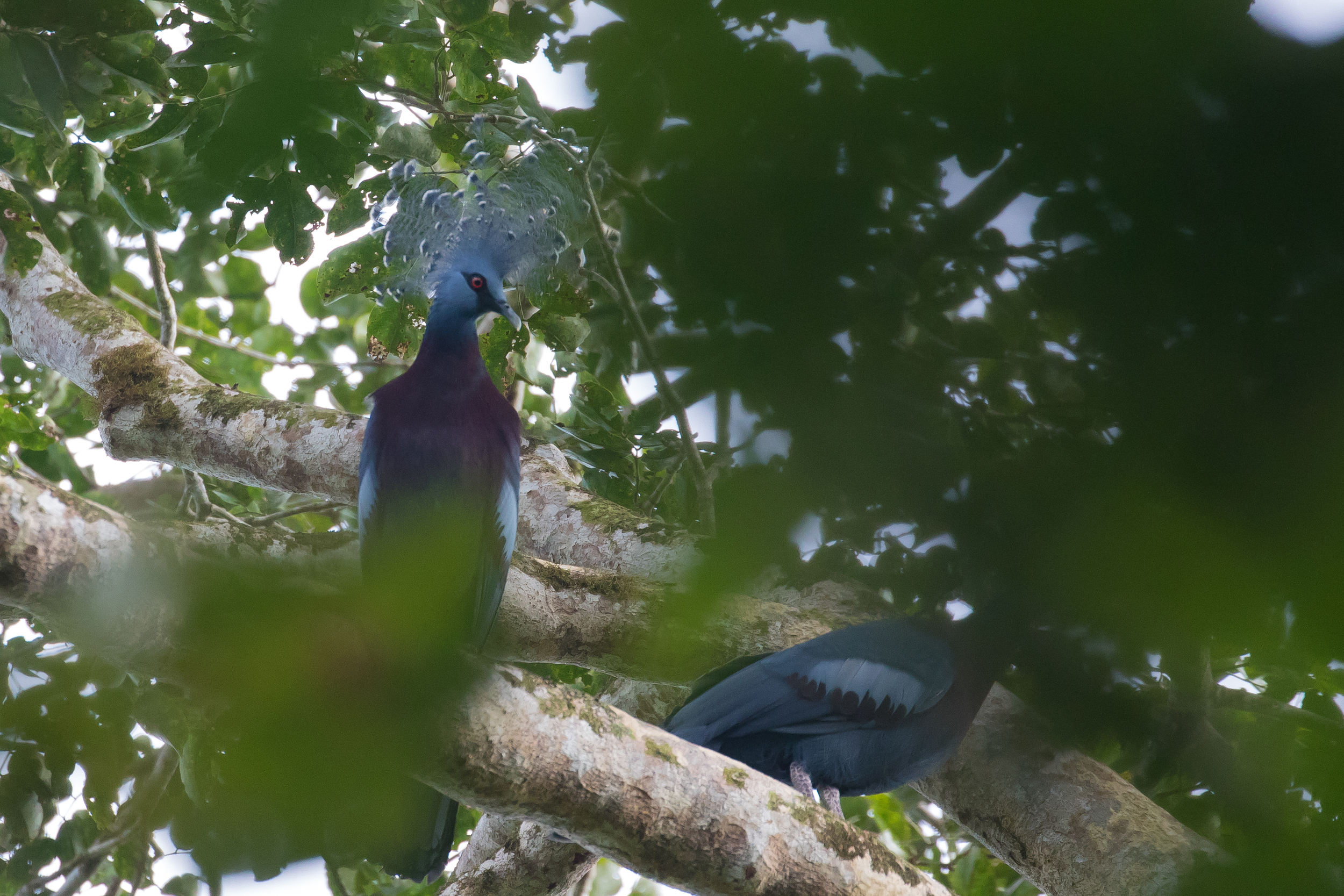
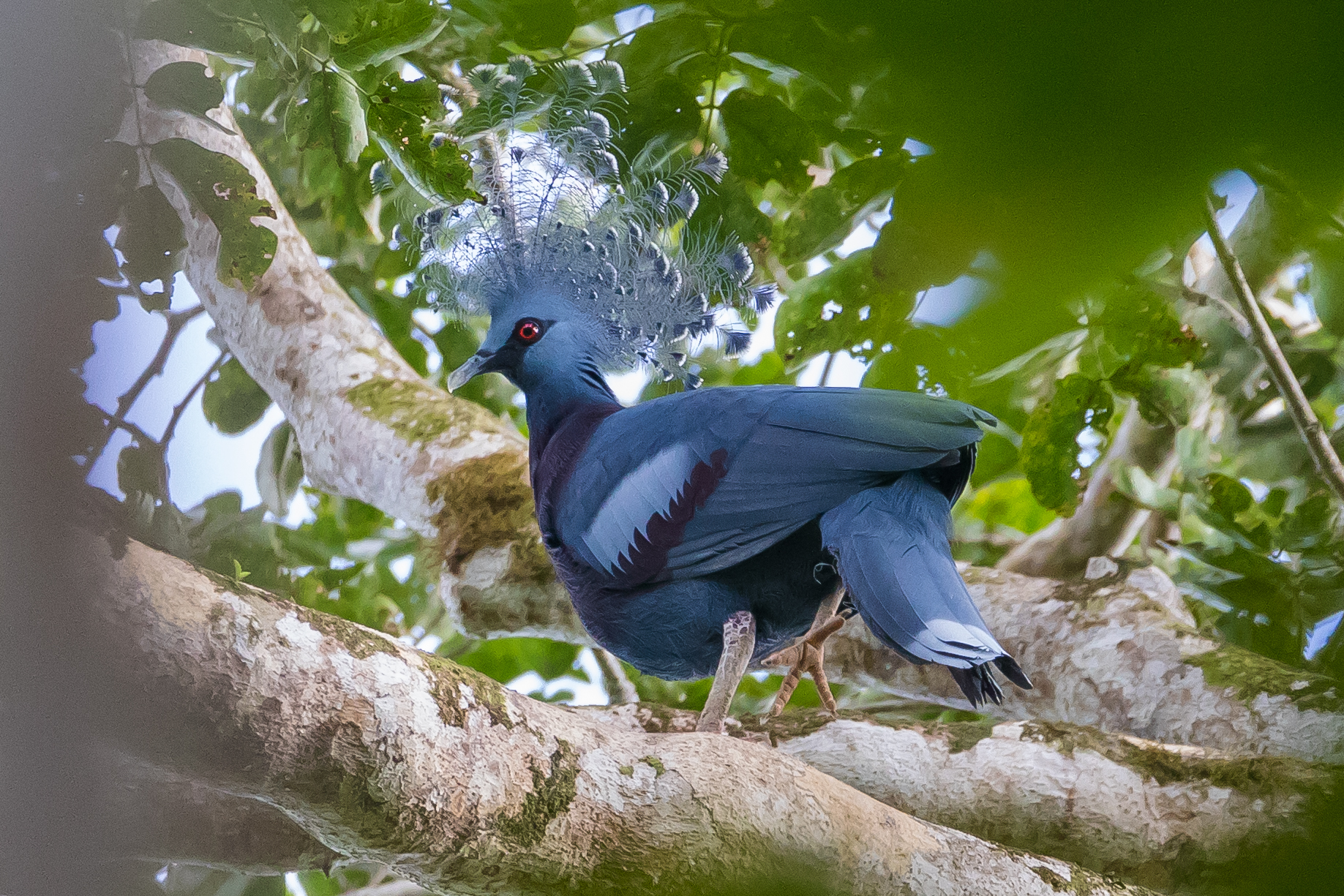
Hi,
Amazing post, I’ve just returned from the same area. Found your blog by looking for Papuan Nightjar photos. Having a 2nd look at your bird, I don’t think it’s papua. Papuan is a much darker bird, with almost black lesser wing coverts, and big black patches on the scapulars. This one looks more like a Grey to me. What do you think?
Yours, Szabolcs
Thx Szabolcs, I’ll need to go back to references and check (I’m away from home at the moment). I recall we were going by features seen in flight and in this pic but the details escape me. Grey would be a long way out of range. I think that Papuan overlaps only with Large-tailed in the West Papuan lowlands.